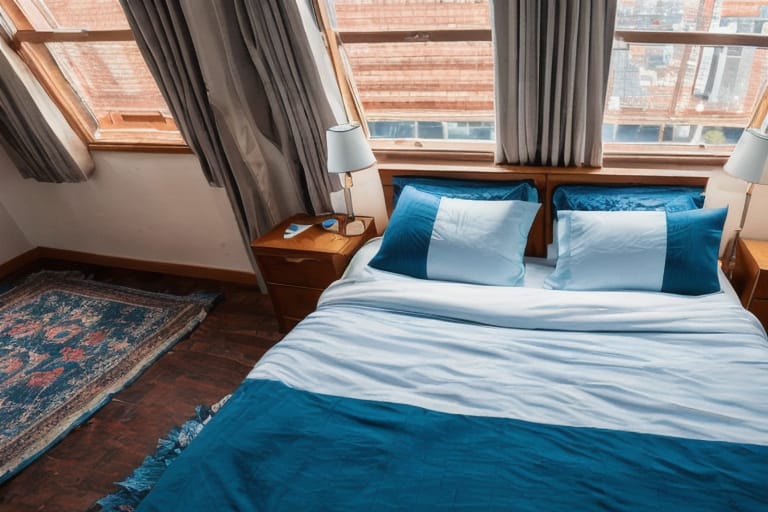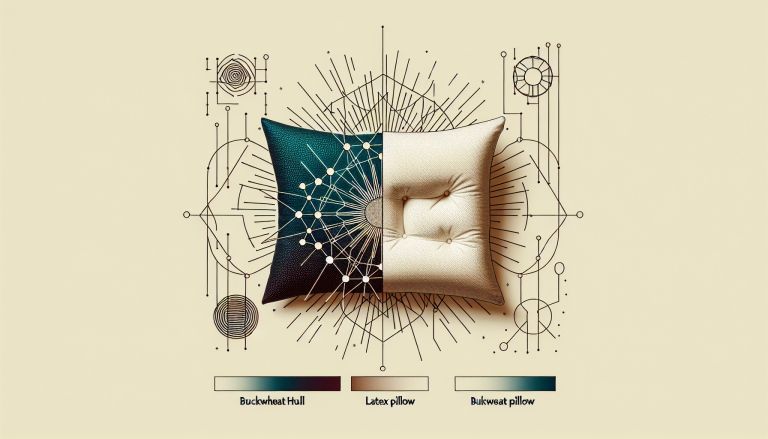Are you looking to add a plush, comfortable down alternative comforter to your bedroom? With so many options to choose from, it can be tricky to figure out which one is right for you. This comprehensive guide covers everything a beginner needs to know about down alternative comforters.
You’ll learn all about the benefits of down alternative compared to regular down, see breakdowns of the most popular brands and models, and get tips for care, maintenance, plus advice to help you select the perfect down alternative comforter. Let’s get cozy!
What Exactly Are Down Alternative Comforters?
Before we dig in, let’s clarify what down alternative comforters actually are.
Down alternative comforters are filled with synthetic materials to imitate the soft, fluffy texture of natural goose or duck down filling. The most common down alternative fibers used are rayon and polyester.
Unlike regular down comforters, down alternative options are choosing for those looking for excellent comfort, warmth, and softness but want a more affordable, hypoallergenic, and easy-care alternative that’s just as luxurious.
How Do Down Alternative Comforters Compare to Regular Down?
Down alternative and regular down comforters share similarities but also have some distinct differences, including with regards to:
- Cost – Down alternative is more budget-friendly
- Allergies – Down alternative is hypoallergenic
- Care – Down alternative is easier to clean and care for
- Durability Over time, down tends to last longer than down alternative
- Lightness – Down is lighter weight than synthetic fills
- Breathability – Down allows more airflow than down alternative
For those with budgets or allergy considerations, down alternative delivers exceptional comfort and softness, similar to down, but at lower price points and without the allergen concerns.
Top Benefits of Choosing Down Alternative Comforter
Down alternative comforters provide many excellent advantages:
- Hypoallergenic – Ideal for allergy sufferers
- Affordable – Costs less than down
- Easy care – Can be machine washed and dried
- Durable – Stands up well to repeated launderings
- Comfortable – Provides plush softness for cozy warmth
- Breathable – Allows adequate airflow and heat regulation
With good durability, easy cleaning, and hypoallergenic properties, down alternative offers excellent bang-for-your-buck when shopping for a quality duvet insert on a budget.
Types of Down Alternative Comforter Fills
When choosing your down alternative comforter, getting familiar with the different types of synthetic fills can be helpful. Two main options exist:
1. Comforel Fiber
- Comforel consists of polyester created from recycled plastic bottles that mimics the cluster-like structure of down feathers.
- It has a fill power around 600 and provides great fluffiness.
- Comforel is hypoallergenic, durable, breathable, and budget-friendly.
2. Rayon or Other Synthetic Fibers
- Rayon consists of wood pulp or plant-based cellulose material spun into fabrics.
- Other synthetics like polyester are also common.
- These mimic down with their soft, billowy texture but they are vegan and hypoallergenic.
- Durability and ease of care are excellent – they can be easily machine washed and dried.
When choosing fill material, consider factors like warmth needs, cost considerations, and if you prefer natural or synthetic fibers.
Understanding Fill Power Ratings
Fill power measures the loft and fluffiness of the comforter filling. Higher numbers indicate more insulation and warmth.
Common fill power ratings for down alternative include:
- 600 – Adequate warmth, most budget-friendly
- 800-900 – Excellent all-season warmth and insulation
- 900+ – Ultra-plush with maximum loft; premium warmth
For year-round use in varying climates, 800-900 fill power delivers reliable, 4-season performance. Go with budget 600 fill power for summer or warmer regions only.
Comparing Construction Methods
Another key decision – baffle box or quilted construction:
| Construction Method | Description | Pros | Cons |
|---|---|---|---|
| Baffle Box | Squares stitched together to prevent fill from shifting | Maximizes loft; very durable; retains fill distribution nicely over time | Takes more skill to construct; pricier |
| Quilted | Fill encased between fabric layers via stitching | Simple construction; budget-friendly price points | Fill may shift more over time; less loft |
Baffle box is best for long term durability and consistent fill distribution but costs more. Quilted delivers reliable performance at lower price points despite some shifting.
Thread Count and Fabric Guide
Higher thread counts indicate more density and softness. For outer shells, common fabrics include:
- 100% cotton sateen – 230-300 thread count range
- 100% cotton percale – Around 300-500 thread count
- 100% cotton batiste – 350-400 thread count is ideal
With excellent breathability, batiste 350 thread count balances durability, softness and breathability beautifully without the premium cost.

Hypoallergenic Certifications to Look For
To provide validation of allergen-free claims, check the certifications:
- OEKO-TEX® Standard 100 ensures protected against harmful substances
- CertiPUR-US® guarantees no ozone-depleting chemicals were used
Reputable brands will provide such safety validations to give buyers peace of mind.
Top-Rated Down Alternative Comforter Brands & Models
Now that we’ve covered the basics about materials and construction, let’s look at some top-rated options on the market along with an overview of notable features and benefits.
1. Downright Sierra Down Alternative Comforter
Fill: 600 fill power Comforel polyester
Shell: 300 thread count, 100% cotton sateen
Sizes: Twin to California King
Price: $90-$160
- Ultra-soft, hotel-worthy comfort
- Hypoallergenic and durable
- Baffle-box construction prevents shifting
- Can be machine washed and tumble dried
- 5-year warranty included
- Budget-friendly price point
With a mid-range 600 fill power and quality construction, the Downright Sierra delivers outstanding comfort and longevity that buyers praise in reviews. Easy care and allergy-friendly features make this a wonderful year-round down alternative.
2. Matouk Montreux Down Alternative Comforter
Fill: Primaloft synthetic + cotton batting
Shell: 300 thread count, 100% fine cotton percale
Sizes: Twin to King
Price: $250-$950
- Luxurious construction for exceptional softness
- PrimaLoft and cotton combine for perfect warmth
- Percale cotton shell is crisp yet breathable
- Baffle box style retains fill distribution beautifully
- Can be machine washed on delicate and air dried
- Hand-guided stitching creates unparalleled quality
For those seeking top-tier luxury and don’t mind splurging, Matouk’s down alternative comforters deliver exceptional quality and refinement. The clever blended PrimaLoft and cotton fill enhances airflow while providing quintessential light plushness.
Care and Cleaning Tips
Caring properly for down alternative comforters ensures they stay fresh, clean, and retain their loft for years. Follow these best practices:
Cleaning Method
- Check label for care instructions
- Most can be machine washed and dried
- Use cold water delicate cycle; low heat for drying
- For whites, add non-chlorine bleach occasionally
Maintenance Between Washes
- Air out the comforter 2-3 times per year
- Use a duvet cover to protect the shell
- Spot clean stains quickly with a damp rag
- Store off-season comforters properly (see tips below)
Proper Storage Tips
- Fold neatly and place in breathable bag
- Store in cool, dry place like shelf or under bed
- Avoid overly compressed storage to maximize loft
- Use cedar chips/packets to deter moths and bugs
Sustainability and Environmental Impact
More brands are focusing on eco-friendly practices, including:
- OEKO-TEX® Standard 100 certified factories and materials
- Recycled synthetics like rPET fills made from plastic bottles
- Organic cotton shell fabrics grown sustainably
Check certifications and material composition on labels to determine how sustainable or ethically-produced a comforter is.
Cost and Value Differences Between Models
Like most home products, price variation between down alternative comforter models primarily comes down to:
- Fill power/quality – Higher fill = higher price tag
- Materials – Premium textiles like silk or high thread count increase cost
- Brand name – Luxury brands demand higher prices generally
- Construction – Baffle box and precise stitching is more labor intensive
- Sizing – Larger comforters (like California King) will be most expensive
Of course there are budget-friendly quality options too. For $100-$250 you can find excellent mid-range models like the Downright Sierra mentioned earlier.
On the higher end, luxury brand comforters like SFERRA or Yves Delorme range from $500 into the thousands.
Choosing the Right Weight Comforter
Down alternative comforters come in a range of thicknesses for year-round use or for specific seasons:
| Type | Best Suited For |
|---|---|
| Summer Weight | Warmer climates or people who sleep hot |
| Lightweight | Spring and fall in moderate climates |
| Mid-Weight | Year-round comforter used on its own |
| Heavy/Extra Warmth | Pair with lightweight in cold winter months |
Choose weight based on your climate needs and if you’ll use additional blankets that impact required insulation levels.
Customer Reviews and Common Feedback
Looking at customer reviews reveals helpful real-world feedback. What do buyers love about their favorite down alternative comforters?
“This comforter has unbelievable loft and warmth but still breathes wonderfully. The quality of the shell fabric and baffle-box stitching really make this stand out.”
“I bought the California King in white and it looks so gorgeous on my bed with my duvet cover. Perfect weight for year-round use here in Pennsylvania with cool nights.”
Some issues mentioned occasionally include:
“I needed to re-fluff it out of the packaging but after a machine wash it filled right back out nicely”
“I wish they offered more color choices but I still love it”
Generally quality, comfort, and durability shine in feedback once buyers found the right model to meet their specific needs.

Frequency Asked Questions
How much does a good down alternative comforter cost?
Expect to pay $100 to $250 for a quality queen-sized down alternative comforter with nice features from a reputable brand. Sales sometimes dip under $100 for more budget options too. High-end luxury models made with premium fabrics and baffle-box construction can range from $250 up to $1,000+.
What’s better for allergies: down or down alternative comforter?
Down alternative comforters are the best options for allergy sufferers because they are hypoallergenic, containing no animal products that trigger allergic reactions. Both clustered down bedding and down alternative should safely encase fills to prevent dust and particles from escaping.
How long does a down alternative comforter last?
The average lifespan ranges 5-8 years. Choosing high-quality materials like tightly woven cotton shells and baffle box construction extends longevity. With proper care including machine washing and low heat drying cycles every few months, a down alternative comforter can maintain excellent cozy resiliency for years before needing replacement.
Is down or down alternative warmer? Which is better?
Goose or duck down provides the absolute warmest natural insulation, thanks to its unbeatable breathability and loft. However, down alternative matches the comfort, feel, durability and nearly matches warmth while being more budget friendly. Unless you sleep really cold or want 100% natural fill for ethical reasons, down alternative delivers comparable performance.
Can you put a down alternative comforter in the dryer?
Yes, down alternative comforters can safely tumble dry on low heat settings. Check care tag recommendations first. Use tennis balls on delicate/air-only cycles to help redistribute filling. Line or low heat drying helps revitalize fill and avoid damage to shell fabrics. Air dry for added longevity.
How do I choose the right size down alternative comforter?
Match the comforter size to your mattress dimensions. Add an extra inch on all sides for best overhang drape. Don’t size down too much or it won’t cover the bed properly. Full/queen and king/California king sizes are fairly interchangeable if needed.








